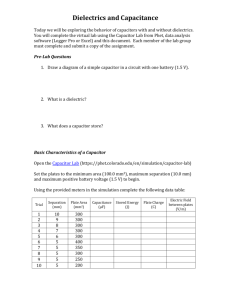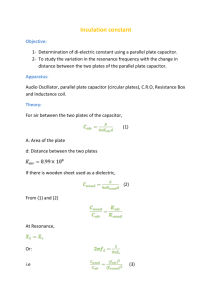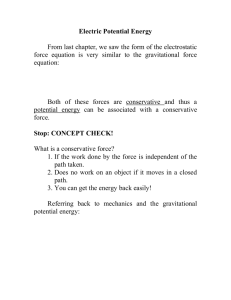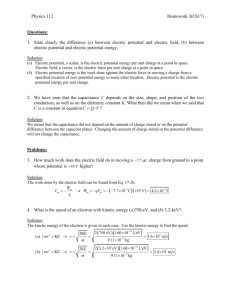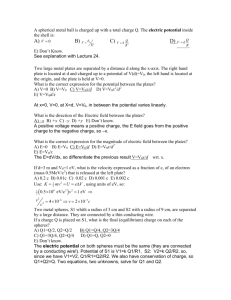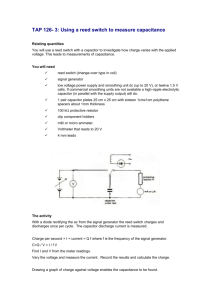Experiments with Parallel Plate Capacitors to
advertisement
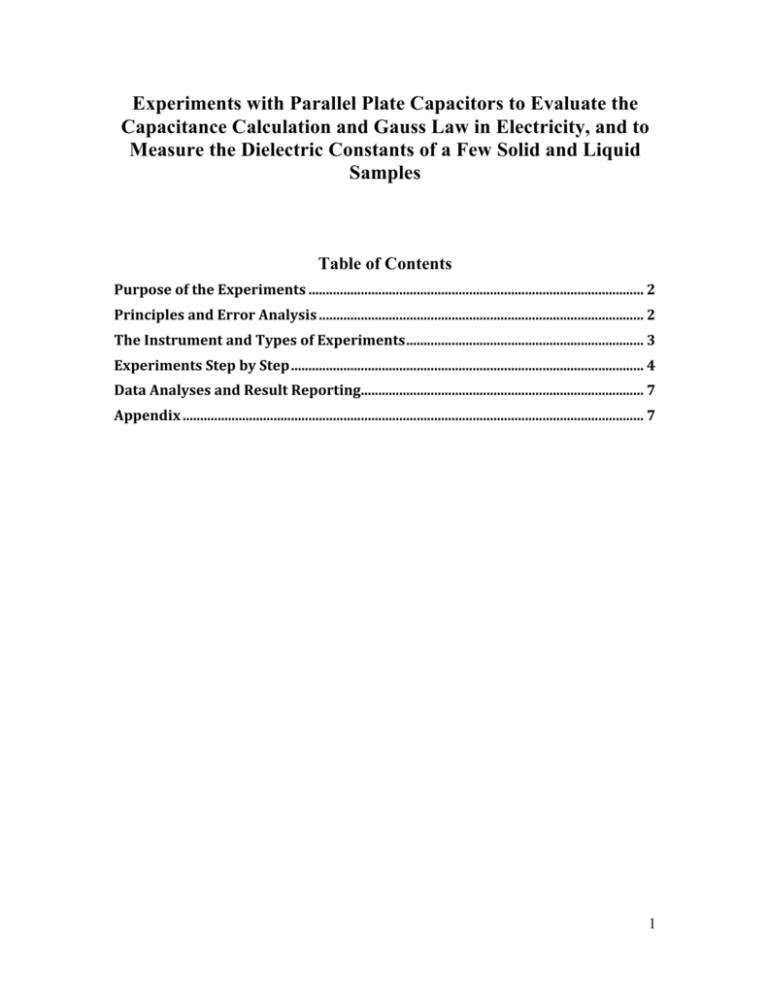
Experiments with Parallel Plate Capacitors to Evaluate the Capacitance Calculation and Gauss Law in Electricity, and to Measure the Dielectric Constants of a Few Solid and Liquid Samples Table of Contents Purpose of the Experiments ................................................................................................ 2 Principles and Error Analysis ............................................................................................. 2 The Instrument and Types of Experiments .................................................................... 3 Experiments Step by Step ..................................................................................................... 4 Data Analyses and Result Reporting ................................................................................. 7 Appendix .................................................................................................................................... 7 1 Purpose of the Experiments Through measurements of the capacitance of a parallel plate capacitor under different configurations (the distance between the two plates and the area the two plates facing each other), one verifies the capacitance formula, which is deduced directly from Gauss’s Law in Electricity. These experiments will enforce the understanding of Gauss’s Law and the assumptions used in deriving the formula for calculating the capacitance of a parallel plate capacitor. Through the comparison of experimental data with theoretical calculations, and data analyses with error estimation and correction, students obtain better understanding of theoretical modeling, formulism and their departure from realistic configurations. Students receive complete training in data acquisition, analyses, including error corrections, and result presentation plus report writing. Also included in the experiments are the measurements of dielectric constants of several solid and liquid samples to enhance the understanding of the concept of an insulator’s dielectric constant. Through these measurements, students get training in using instruments such as digital multi-meter, digital capacitance meter, micrometer head, and understand measurement errors that come from instruments. Principles and Error Analysis A parallel plate capacitor is made of two metal plates that are parallel to each other. The capacitance is determined by the distance d between the two plates, the area A they face each other plus the insulating material and its dielectric constant. The formula for the capacitance is deduced directly from Gauss’s Law in Electricity. When an electric voltage V is applied to the two plates, charges introduced to the plates establish an electric field E between them, as illustrated in the figure on the left. When the size of the plates is much larger than the distance between them, this electric field E approximates to that when the plates are infinitely large and can be calculated through Gauss’s Law. In the figure σ is the charge density, ε is the dielectric constant of the material between the plates. According ! to the definition of capacitance 𝐶 ≡ ! , we can derive the formula for the capacitance of this parallel plate capacitor: 𝐶= 𝑄 𝐴 =𝜀 𝑉 𝑑 Here ε = ε rε 0 is the dielectric constant, ε 0 = 8.854 ×10 −12 F/m is the permittivity of vacuum, ε r is the relative dielectric constant of the material between the plates. For air εr ≅1 ,for an ordinary printing paper εr ≅ 3.85 ,for water εr ≅12.9 . 2 Possible sources of errors: (1) from theoretical modeling: the electric field along the edges of the plates cannot be calculated using Gauss’s Law. When the distance between the two plates is not much smaller than the size, this edge effect is no longer negligible hence the above formula under the assumption that the plates are infinitely large is no longer correct or at least precise. When the two plates are slightly not parallel with each Δd other, one can find the correction to the capacitance to be ΔC = −C . Here Δd d represents the average unparallelism. It is clear that this correction becomes significant when d is not much larger than Δd, for example d < 10 × Δd . When the assumption of parallelism is no longer valid, for example when d ≈ Δd , the charges on the plates are no longer evenly distributed, the electric field generated by each plate is no longer parallel to each other hence the field between the plates cannot be obtained by a simple addition of the fields of the plates. (2) from measuring instruments: thickness of the two metal plates that make up the parallel plate capacitor plus measuring wires and probes provide a body capacitor that is additional to the parallel plate capacitor. This body capacitance is small and is not a function of the distance d between the plates. It only becomes significant when d is large (hence C is small). (3) from mistakes of the operator: for example, misread the instruments or typos in records. By changing the parameters in the above formula ( d, A and ε = ε rε 0 ) and measure the capacitance of the parallel plate capacitor, one can verify this formula that is deduced from Gauss’s Law in Electricity. The Instrument and Types of Experiments The instrument consists of a parallel plate capacitor with variable d (the distance between the plates) and A (the area the plates face each other), as shown in the figure below, another parallel plate capacitor with fixed d and A, plus a digital capacitance meter and a multi-meter (used to measure resistance). In addition there are three insulating plates that can be used as dielectric material between the two metal plates, and a ruler. In the variable capacitor the parameter d is set by the micrometer head of the stage with a precision of 0.01 mm and a range from 0.01 mm to 10 mm, which is 0.01% - 10% of the size of the metal plate (a 10 cm ×10 cm square). The parallelism of the two metal plates is determined by the stage assembly, and is about 0.03 mm. The parameter A is changed by sliding the bottom plate with a precision of 1 mm. The range of A is from 0 to 10 cm×10 cm. There can be two types of experiments. The first type uses the variable capacitor to check the relationship between the capacitance C and the parameters d, A and ε r . Setting the value of d through the micrometer head, one measures the corresponding C to verify that 3 1 . At a chosen d, for example d = 0.5 mm or 1.0 mm, sliding the bottom metal plate d to change A, one measures the corresponding C to verify that C ∝ A . To check the effect of ε r in C, one select an insulating plate and place it between the two metal plates, raise the bottom plate so that the distance d is the thickness of the insulator. Be careful and avoid over tightening and stripping the precision threads of the micrometer head. By measuring the capacitance with and without the insulator one can calculate the value of εr of this material. The second type of experiments employs the fixed capacitor. Measure the capacitance of this capacitor in air, and then immerse the capacitor in the (nonconducting) liquid of which you want to measure its dielectric constant. As an example of how physics is the foundation of instrumentation, we use this fixed capacitor as a meter to measure the liquid level of a known ε r . Place the capacitor with the plates vertical in a container and then add liquid (for example distilled water), when the liquid reaches a height h, ignoring the body capacitance at this moment, one can obtain the value of h ε through this formula C = 0 a "#a + (εr −1) h$% . Calculate for h and then verify that using the d ruler. C∝ Experiments Step by Step The following experiments should be carried out by a group of 2 to 3 students. Each student must take the measurement while the other(s) help record data. The recorded 2 to 3 sets of data of the same measurement settings will be used to find and correct operator mistakes. 1 • Experiment 1, verify that C is inversely proportional to d, that is C ∝ , in the d A formula of a parallel plate capacitor C = ε . d Steps: Read the appendix about how to use the micrometer head. Slide the bottom plate until the two metal plates completely overlap. Connect the digital multimeter to the two plates and measure the resistance between them. As the plates do not touch each other, the multi-meter reads infinite resistance. Now raise the bottom plate until the multi-meter just start to read 0 ohm. Record the reading of micrometer head and set that to be d = 0 mm. Now you can proceed to set the d and use the capacitor meter to measure the corresponding C. Record data in the Excel file provided, or in any format you choose. That’ll be your “raw” data. The Excel file has formulas entered for data analyses such as estimating the errors and plotting the results. One measurement result, as an example, is shown in Figure 1. In Figure 2 we compare the measurements with those calculated from the formula A C = ε , including those after the correction of unparallelism and body d capacitance. The estimate of Δd is from minimizing the difference between measurement and calculation in the range of d = 0.20 – 0.35 mm. Of course this is 4 a coarse estimate. Students are encouraged to propose and carry out their own error estimate. Figure 1, the measured capacitance (raw data, no correction added) as a function of 1/d. By eye this is a straight line. Figure 2, comparison of the measured capacitance (raw and corrected) with calculation, as a function of d. After correction and d > 2 mm, the difference between measured and calculated is below 5%, and decreases systematically, indicating the edge effect that is more significant as d increases. Students should follow their instructor to perform more thorough data analyses, for example to include the errors from the capacitance meter, and set confidence 1 level in checking the assumption that C ∝ d • Experiment 2, verify that C is proportional to A, that is C ∝ A , in the formula of A C =ε . d Steps: slide the bottom plate until the two metal plates completely overlap. Set the desired d, for example use d = 1 mm. This value should be determined taking into account the unparallelism, the edge effect and the meter error. Students will need to justify their choices, and compare results from different settings. The area A 5 that the two plates overlap can be changed by sliding the bottom plate. Measure C as A changes and plot the result. An example is shown in Fig. 3. A question: when the two plates do not overlap at all, what do you read from the capacitance meter and what that reading means? Is this a way to measure the body capacitance? If yes, compare the number with what you’ve estimated in experiment 1, and explain the difference if there are any. Figure 3, the measured capacitance (raw data, no correction added) as a function of A. By eye this is a straight line. • Experiment 3, verify the relationship of C with the dielectric constant in the A formula C = ε . d The steps are similar to those in Experiment 1. Place one sample of the solid insulating plate between the two metal plates, raise the bottom plate so that there is no air gap between the sandwich, and measure the capacitance. After that remove the insulating plate while keeping the distance between the two metal plates (the stage can be locked if needed), and measure the capacitance again. Compare the two numbers of C, one can calculate the dielectric constant of the insulating material. Check what you get with what you can find from reference or internet and explain possible differences. Do you need to correct of factors such as the body capacitance in your calculation? • Experiment 4, measure dielectric constants of non-conducting liquid samples. Use a container for the liquid, compare the capacitance of the fixed capacitor in air and in liquid to calculate for the dielectric constant, as in Experiment 3, pay attention to corrections such as the body capacitance. Now compare your results with what from references and see if the difference is smaller or larger as in the case of Experiment 3, and why? 6 • Experiment 5, measure liquid level using the fixed capacitor The fixed capacitor is made of two square metal plates of the size of 10 cm×10 cm, with the distance d = 1.00 mm. Set this capacitor vertically in the container of Experiment 4, and fill the container with liquid (for example water). When the liquid reaches a height h, measure the capacitance. The height h can be measured with a ruler. Repeat this measurement at several values of h, and record data. Use ε this formula C = 0 a "#a + (εr −1) h$% to calculate h from C, and compare your d results with the numbers obtained using the ruler. If they do not agree, what kind of corrections you need to make in order to get a better result? Do you know other liquid level measuring instruments and the physics behind them? Data Analyses and Result Reporting Experimental data submitted must be in the format of the raw data. Data analyses can be performed using Excel but students are encourage to use more powerful tools such as root (https://root.cern.ch/drupal/). In the lab report on each of the 5 experiments, one needs to explain the physics, provides the diagram to show how instruments are connected and which range of the meter was used (and why). The methods in data analyses and error estimation must be clearly stated. The final results can be presented using graphs (as in this manual) or tables. Questions raised in this manual also need to be answered. If you have questions about the experiments, you can write them in the discussion part of the your report. Appendix How to read a micrometer head: the scale on the micrometer is 1 mm. The ticks on either side the longitudinal line is offset by 0.5 mm. The knob has 50 markers with each corresponding to 0.01 mm, or 10 microns. This is the positioning precision of the stage and the distance between the two plates. When the two plates are very close to each other, be careful when turning the knob so as not to strip the fine threads. How to use the capacitance meter: in the experiment we only use the 2000 pF or 200 pF range. Before any measurements, the meter needs to be zeroed. The probes can be plugged into the two holes marked with Cx. The other side of the probes (with a clamp) is connected to the metal plate. Measurement precision and other information about this meter is in the following table: 7 Range Relative precision Resolution Measurement frequency 200 pF 0.5% 0.1 pF 800 Hz 2000 pF 0.5% 1 pF 800 Hz 20 nF 0.5% 10 pF 800 Hz 200 nF 0.5% 100 pF 800 Hz 2000 nF 0.5% 1 nF 800 Hz 20 µF 0.5% 10 nF 80 Hz 200 µF 0.5% 100 nF 8 Hz 2000 µF 1% 1 µF 8 Hz 20000 µF 2% 10 µF 8 Hz 8

